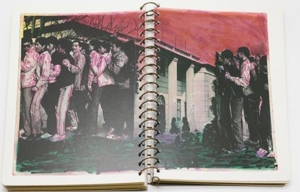
These article expresses only my own opinion. I’m not a ruler.
I am sad and upset.
As far as i remember, i have always seen trends in photography.

Just to be clear, what i used to call trends were some decades ago more common subjects and reflects of social identifications. You can spot the decade, sometime the year a picture has been taken just because of his content.
But by a post-millenium2k survey i am confused about how fast nowadays a young photographer copy another without any intent of singularity. More : they copy several photographer styles, they don’t mix the styles to create their own through discoveries, no no, they make one serie like X, another serie like Y, etc.
One bad side is “copying” as aesthetic copycat, they don’t understand topics, context or narrative.
You can blame the gear, affordable, blame these lenses and cameras which have their own personalities, here a Hasselblad HDR, there a Leica bokeh, and a —oh-so-sweet— vignette, here a complete studio shot as recommended by this famous photography-tech website…
Experiments help the bravest to copy their icons, here the grainy, here the saturated colors…
If only they keep their satisfactory replicas as a personal diary, everything should be fine. Unfortunately year after year, they want the next rung, the fame, the podium, quick.
So here we are with non-sense portfolios, no narrative, no statement to clear our troubled consideration.If you suggest politely the déja-vu, you’ll here it’s An Hommage.
If you tell about the confusion of styles, you’ll here it’s a Compilation of the Best Shots
And if you ask about the personal instigation, the research, the meaning or the story, you may be watched as a blind ignorant.

And later you’ll hear on your back that you just don’t understand anything and that your criticism is harsh and not constructive. Come on…
So, here are the new trends :
First, the comeback of black and white as : silhouettes of single person, silhouette of close-up objects, negatives and high-key style are also applied

Second : Found photography, from random topic to family negatives, some colouring or add-on effects could be applied (sewing, drawing, hole punching, glitter powder, etc.)
Third, cut-out and assemblages. And i have to admit that some are really deserving the purpose of stories.
Fourth, the cinematic framing and dream-like scenes, who have never really disappeared but who’s growing exponentially. To stage a no-idea picture don’t give sense to the picture itself.
Extra : you can apply several trends on a single composition.

Get me right : i’m not against. Some are working, some are well executed and some were pioneer ideas at a time. It’s more a note for uninspired photographers to whom i recommend to get rid of these clichés. There’s so much to tell, so much to explore, if you can get away from influences to find your own signature. And even without “a style” you can build a good narrative or cover an interesting subject. The content first, the style later.
Alexandre.
As a reminder, here’s an extract of a post from thephotofundamentalist.com last year.
“I don’t know if any of you have visited Les Rencontres d’Arles, which is a huge photography festival in the south of France, but if you do you will find dozens of ‘projects’ that look almost identical to the Troilo’s Charleroi series (I saw a dozen during one screening by one photography institution that so irritated my hosts that they walked out). There will be a few naked scenes, because these are mandatory. There will be guns, possibly hunting guns and some dead animals. There will be people standing in woodland (usually naked), quite possibly at night. There may be a blurry photo of a strange face or eerie looking passing animal, usually lit by flash. Car headlights and/or flashlights are often used. Most of the portraits will involve dead pan (often awkward) expressions standing straight on the the camera. Drug or alcohol abuse is useful as a final touch. The plague of such photographs of this kind is so overwhelming in volume and their commonality so astonishing, that you could swap 50% of the images from each series between series and it would make no material difference to anything.”
-Thomas Stanworth. March, 2015. thephotofundamentalist.com

Illustrations from top to bottom : (featured on title : Gregory Crewsdon) Julie Cockburn, Charles Freger, Sun Yanchu, Ruth Van Beek, Gregory Crewsdon, Matthieu Bourel.

Leave a comment